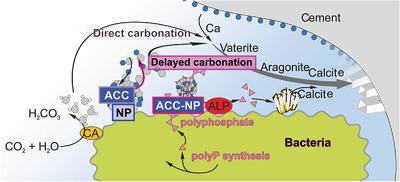当前位置:
X-MOL 学术
›
Biotechnol. J.
›
论文详情
Our official English website, www.x-mol.net, welcomes your feedback! (Note: you will need to create a separate account there.)
Amorphous Polyphosphate and Ca-Carbonate Nanoparticles Improve the Self-Healing Properties of both Technical and Medical Cements.
Biotechnology Journal ( IF 4.7 ) Pub Date : 2020-06-04 , DOI: 10.1002/biot.202000101 Emad Tolba 1, 2 , Xiaohong Wang 1 , Shunfeng Wang 1 , Meik Neufurth 1 , Maximilian Ackermann 3 , Heinz C Schröder 1, 4 , Werner E G Müller 1
Biotechnology Journal ( IF 4.7 ) Pub Date : 2020-06-04 , DOI: 10.1002/biot.202000101 Emad Tolba 1, 2 , Xiaohong Wang 1 , Shunfeng Wang 1 , Meik Neufurth 1 , Maximilian Ackermann 3 , Heinz C Schröder 1, 4 , Werner E G Müller 1
Affiliation

|
Cement is used both as a construction material and for medical applications. Previously, it has been shown that the physiological polymer inorganic polyphosphate (polyP) is morphogenetically active in regeneration of skin, bone, and cartilage. The present study investigates the question if this polymer is also a suitable additive to improve the self‐healing capacity not only of construction cement but also of inorganic bone void fillers. For the application in the cement, two different polyP‐based amorphous nanoparticles (NP) are prepared, amorphous Ca‐polyP NP and amorphous Ca‐carbonate (ACC) NP. The particles are integrated into poly(methyl methacrylate) in a concentration ratio of 1:10. This material applied onto Portland cement blocks either by brush application or by blow spinning strongly accelerates the self‐healing property of the cement after a 10 day incubation period. Most likely, this process depends on bacteria and their membrane‐associated alkaline phosphatase, resulting in the formation of calcite from ACC. In a second approach, polyP is integrated into a calcium‐silicate‐based cement used in reconstitutive medicine. Subsequently, the cement becomes softer and more elastic. The data show that bioinspired polyP/ACC NP are suitable additives to improve the self‐healing of construction cement and to biologize bone cement.
中文翻译:

非晶态多磷酸盐和碳酸钙纳米颗粒可改善技术和医疗水泥的自愈性能。
水泥既用作建筑材料,也用于医疗应用。以前,已经显示出生理聚合物无机多磷酸盐(polyP)在皮肤,骨骼和软骨的再生中在形态上具有活性。本研究调查了这种聚合物是否还是一种既能提高建筑水泥的自愈能力又能提高无机骨空隙填料自愈能力的合适添加剂的问题。为了在水泥中应用,准备了两种不同的基于polyP的无定形纳米颗粒(NP),即无定形Ca-polyP NP和无定形碳酸钙(ACC)NP。颗粒以1:10的浓度比整合到聚(甲基丙烯酸甲酯)中。经过10天的温育期后,通过刷涂或吹纺将这种材料施加到波特兰水泥块上,可大大加速水泥的自愈性能。此过程最有可能取决于细菌及其与膜相关的碱性磷酸酶,从而导致ACC形成方解石。在第二种方法中,将polyP整合到用于重建医学的硅酸钙基水泥中。随后,胶结剂变得更软且更有弹性。数据表明,受生物启发的polyP / ACC NP是合适的添加剂,可改善建筑水泥的自愈性并使骨水泥生化。polyP已整合到用于重建医学的硅酸钙基水泥中。随后,胶结剂变得更软且更有弹性。数据表明,受生物启发的polyP / ACC NP是合适的添加剂,可改善建筑水泥的自愈性并使骨水泥生化。polyP已整合到用于重建医学的硅酸钙基水泥中。随后,胶结剂变得更软且更有弹性。数据表明,受生物启发的polyP / ACC NP是合适的添加剂,可改善建筑水泥的自愈性并使骨水泥生化。
更新日期:2020-06-04
中文翻译:

非晶态多磷酸盐和碳酸钙纳米颗粒可改善技术和医疗水泥的自愈性能。
水泥既用作建筑材料,也用于医疗应用。以前,已经显示出生理聚合物无机多磷酸盐(polyP)在皮肤,骨骼和软骨的再生中在形态上具有活性。本研究调查了这种聚合物是否还是一种既能提高建筑水泥的自愈能力又能提高无机骨空隙填料自愈能力的合适添加剂的问题。为了在水泥中应用,准备了两种不同的基于polyP的无定形纳米颗粒(NP),即无定形Ca-polyP NP和无定形碳酸钙(ACC)NP。颗粒以1:10的浓度比整合到聚(甲基丙烯酸甲酯)中。经过10天的温育期后,通过刷涂或吹纺将这种材料施加到波特兰水泥块上,可大大加速水泥的自愈性能。此过程最有可能取决于细菌及其与膜相关的碱性磷酸酶,从而导致ACC形成方解石。在第二种方法中,将polyP整合到用于重建医学的硅酸钙基水泥中。随后,胶结剂变得更软且更有弹性。数据表明,受生物启发的polyP / ACC NP是合适的添加剂,可改善建筑水泥的自愈性并使骨水泥生化。polyP已整合到用于重建医学的硅酸钙基水泥中。随后,胶结剂变得更软且更有弹性。数据表明,受生物启发的polyP / ACC NP是合适的添加剂,可改善建筑水泥的自愈性并使骨水泥生化。polyP已整合到用于重建医学的硅酸钙基水泥中。随后,胶结剂变得更软且更有弹性。数据表明,受生物启发的polyP / ACC NP是合适的添加剂,可改善建筑水泥的自愈性并使骨水泥生化。



























 京公网安备 11010802027423号
京公网安备 11010802027423号